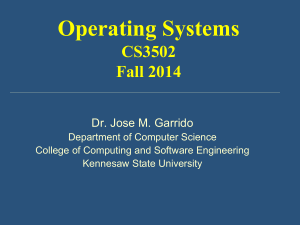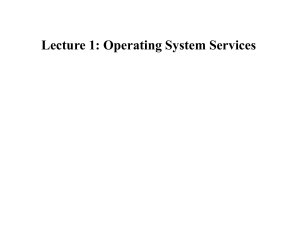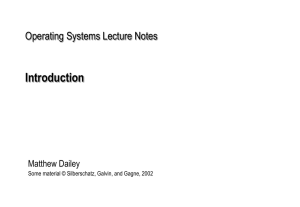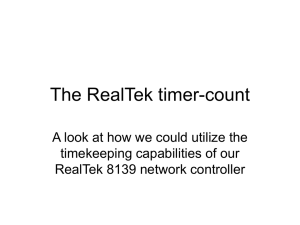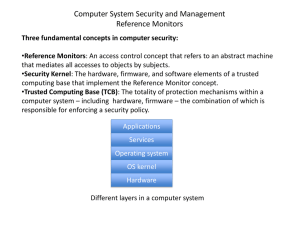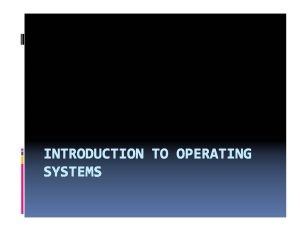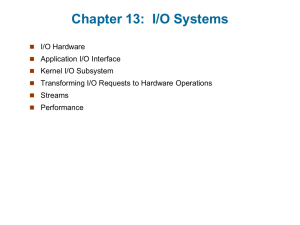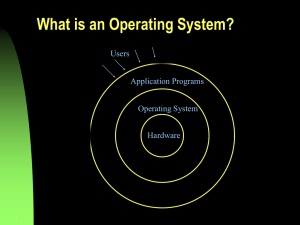Chapter 1 PowerPoint
advertisement
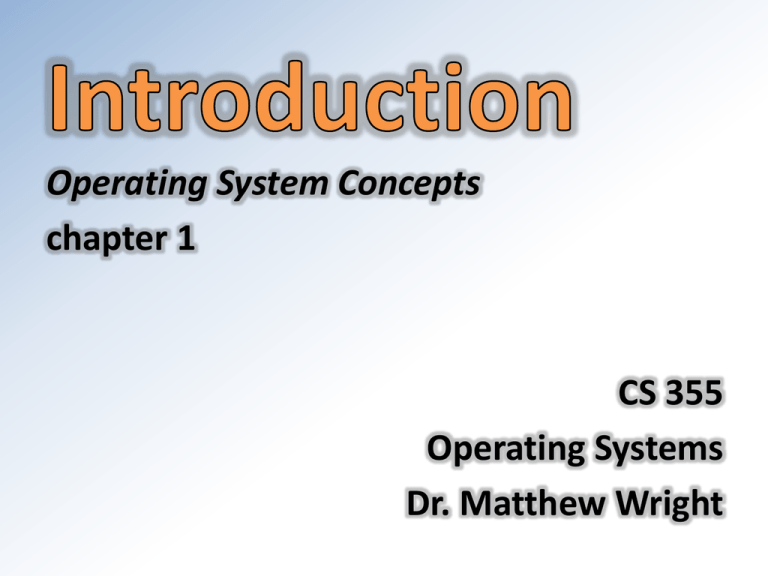
Operating System Concepts chapter 1 CS 355 Operating Systems Dr. Matthew Wright What do operating systems do? • • • • • • • manage processes manage memory and computer resources provide security features execute user programs make solving user problems easier make the computer system convenient to use use the computer hardware in an efficient manner What is an operating system? • OS is a resource allocator: manages all system resources, decides between conflicting requests for efficient and fair resource use • OS is a control program: controls execution of programs to prevent errors and improper use of the computer • “Everything a vendor ships when you order an operating system.” (Certainly this varies widely.) • “The one program running at all times on the computer” is the kernel. Everything else is either a system program (ships with the operating system) or an application program. Should an operating system include applications such as web browsers, mail programs, games, etc? Computer System Operation • The bootstrap program is loaded at power-up or reboot – Typically stored in ROM or EPROM (generally known as firmware) – Initializes all aspects of system – Loads operating system kernel and starts execution – Waits for an event to occur • An event is signaled by an interrupt Interrupts • Interrupt transfers control to the interrupt service routine generally, through the interrupt vector, which contains the addresses of all the service routines. • Interrupt architecture must save the address of the interrupted instruction. • A trap is a software-generated interrupt caused either by an error or a user request. • An operating system is interrupt driven. Multiprogramming • Why multiprogramming? Efficiency. – Single user cannot keep CPU and I/O devices busy at all times – Multiprogramming organizes jobs (code and data) so CPU always has one to execute – Many jobs are kept in memory – One job selected and run via job scheduling – When it has to wait (for I/O for example), OS switches to another job • Timesharing (multitasking) is logical extension in which CPU switches jobs so frequently that users can interact with each job while it is running, creating interactive computing – Response time should be < 1 second – Each user has at least one program executing in memory (one process) – If several jobs ready to run at the same time, the OS performs CPU scheduling – If processes don’t fit in memory, swapping moves them in and out to run – Virtual memory allows execution of processes not completely in memory OS Operations • Hardware interrupts the operating system • Software error creates an exception or trap (e.g. division by zero) • Software can also interrupt via a system call to request for operating system service • Other process problems include infinite loop, processes modifying each other or the operating system OS Operations • Dual-mode operation allows OS to protect itself and other system components by distinguishing between user mode and kernel mode. • Mode bit provided by hardware: provides ability to distinguish when system is running user code or kernel code. • Some instructions designated as privileged, only executable in kernel mode. • A system call changes mode to kernel, return from call resets it to user. Timer The timer prevents processes from hogging resources or looping infinitely • Timer is a counter, set for a specific number of clock cycles • OS decrements the counter each clock cycle • When counter is zero, an interrupt occurs • OS then decides whether to allow the process to regain control or terminate the program that exceeds allotted time Practice Exercise 1.8 Which of the following instructions should be privileged? a) Set the value of the timer b) Read the clock c) Clear memory d) Issue a trap instruction e) Turn off interrupts f) Modify entries in device-status table g) Issue a system call h) Access I/O device Process Management • A process is a program in execution. It is a unit of work within the system. Program is a passive entity, process is an active entity. • A process needs resources to accomplish its task (e.g. CPU, memory, I/O, files, initialization data). • Process termination requires reclaim of any reusable resources. • Single-threaded process has one program counter specifying location of next instruction to execute (process executes instructions sequentially, one at a time, until completion). • Multi-threaded process has one program counter per thread. • Typically a system has many processes, some user, some operating system running concurrently on one or more CPUs. Process Management The operating system is responsible for the following activities in connection with process management: • Creating and deleting both user and system processes • Suspending and resuming processes • Providing mechanisms for process synchronization • Providing mechanisms for process communication • Providing mechanisms for deadlock handling Memory Management • Memory contains both data and instructions. • Memory management determines what is in memory when, in order to optimize CPU utilization and computer response to users. • Memory management activities: – Keeping track of which parts of memory are currently being used and by whom – Deciding which processes (or parts thereof) and data to move into and out of memory – Allocating and deallocating memory space as needed Storage Management • OS provides uniform, logical view of information storage – Abstracts physical properties to logical storage unit, the file – Storage devices have varying properties such as access speed, capacity, data-transfer rate, access method (sequential or random) • File-System management – Files usually organized into directories – Access control on most systems to determine who can access what – OS activities include Creating and deleting files and directories Primitives to manipulate files and directories Mapping files onto secondary storage Backup files onto stable (non-volatile) storage media Levels of Memory/Storage I/O Subsystem • One purpose of OS is to hide peculiarities of hardware devices from the user. • I/O subsystem responsible for – Memory management of I/O including buffering (storing data temporarily while it is being transferred), caching (storing parts of data in faster storage for performance), spooling (the overlapping of output of one job with input of other jobs) – General device-driver interface – Drivers for specific hardware devices Protection and Security • Protection: any mechanism for controlling access of processes or users to resources defined by the OS • Security: defense of the system against internal and external attacks – Huge range, including denial-of-service, worms, viruses, identity theft, theft of service • Systems generally first distinguish among users, to determine who can do what – User identities include name and associated number, one per user – User ID then associated with all files, processes of that user to determine access control – Group identifier allows set of users to be defined and controls managed, then also associated with each process, file Exercise 1.32 Identify several advantages and disadvantages of open-source operating systems. What types of people would find each aspect to be an advantage or disadvantage?


